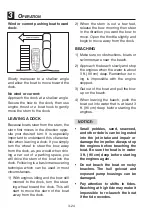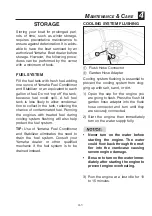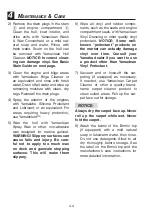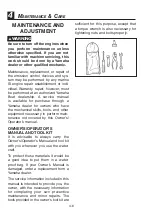
O
PERATION
3
3-27
POST-OPERATION
CHECKS
POST-OPERATION CHECKS
These post-operation procedures are
developed to help preserve the long-
term appearance and reliability of your
boat. Perform these procedures as
soon as possible after the boat is
loaded back on the trailer after the
day’s use.
Some owners prefer to moor their boat
seasonally, rather than keeping it on
the trailer between uses. Extended
mooring is not recommended. Proper
flushing of the cooling system on each
engine is not possible with the boat in
the water. In addition, conditions such
as stray electrical voltage in the water,
marine organisms, and saltwater cor-
rosion can adversely affect the life
of many boat components.
NOTICE:
Leaving the boat in the water for
extended periods will accelerate the
rate of normal deterioration of the
jet pump components, sacrificial
anodes, hull finish and other com-
ponents.
If you do decide to moor your boat, be
sure to remove it from the water peri-
odically to clean the hull and jet pump
area. The frequency of maintenance
required will depend upon whether the
water is salt or fresh and other local
water conditions.
1) After putting the boat on the trailer,
flush cooling system on each engine
to prevent the cooling system from
clogging up with salt, sand, or dirt.
Refer to page 4-1 for the cooling
system flushing procedure.
2) Drain residual water from the exhaust
system by starting the engine, then
alternately pushing the control lever
up to half throttle and back to idle for
10 to 15 seconds.
Never run the engine at full throttle
or for more than 15 seconds while
the boat is out of the water. The
engine may overheat and/or seize.
3) Wash down the hull, helm, and both
jet drive units with fresh water.
4) Open the rear platform hatch and
remove the clean-out-port caps to
let any water drain that has pooled
on them. If the boat will be stored on
the trailer nearby, leave the caps out
until you prepare to launch the boat
again. If the boat will be transported
on the trailer any distance, tempo-
rarily reinstall the caps and close
the platform hatch until you get
home. Open the hatch again when
you arrive and remove the caps as
before. Leave the caps loose until
you plan to transport the boat on the
trailer again.
NOTICE:
Leaving the
caps out when you are not using
or transporting the boat helps
keep them from becoming stuck
in the clean-out ports.
















































